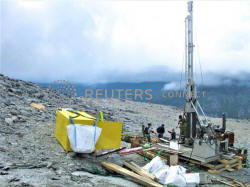Mining magnets: Arctic island finds green power can be a curse
 Send a link to a friend
Send a link to a friend
 [March 02, 2021] By
Jacob Gronholt-Pedersen and Eric Onstad [March 02, 2021] By
Jacob Gronholt-Pedersen and Eric Onstad
COPENHAGEN (Reuters) - In the tenth
century, Erik the Red, a Viking from Iceland, was so impressed with the
vegetation on another Arctic island he had found he called it "the green
land." Today, it's Greenland's rocks that are attracting outsiders -
superpowers riding a green revolution.
The world's biggest island has huge resources of metals known as 'rare
earths,' used to create compact, super-strong magnets which help power
equipment such as wind turbines, electric vehicles, combat aircraft and
weapons systems.
The metals are abundant globally, but processing them is difficult and
dirty - so much so that the United States, which used to dominate
production, surrendered that position to China about 20 years ago.
As Greenland's ice sheet and glaciers recede, two Australia-based mining
companies - one seeking funding in the United States, the other
part-owned by a Chinese state-backed firm - are racing for approval to
dig into what the U.S. Geological Survey (USGS) calls the world's
biggest undeveloped deposits of rare earth metals.

The contest underscores the polluting side of clean energy, as well as
how hard it is for the West to break free of China in production of a
vital resource. Rare earth metals have many uses, and last year China
produced about 90% of them, according to Toronto-based consultancy
Adamas Intelligence. As U.S.-China tensions mount, President Joe Biden's
administration said last month it will review key U.S. supplies,
including rare earths, to ensure other countries cannot weaponise them
against the United States.
Each Greenland mine would cost about $500 million to develop, the
companies say. Both plan to send mined material away for final
processing, an activity that is heavily concentrated in China. The only
rare earth mine now operating in the United States – Mountain Pass in
California – is partly owned by a Chinese state-backed company that
currently sends material mined in the U.S. to China for processing.
The Greenland sites are less than 16 km (10 miles) from each other at
the southern tip of the island, near a UNESCO World Heritage Site.
Debate on them has triggered a political crisis in the capital of Nuuk,
forcing a general election on the island of 56,000, due in April. Many
Greenlanders, while concerned about pollution, feel mining is key to
develop their fragile economy. In a 2013 poll, just over half said they
want raw materials to become the country's main source of income.
The country may ultimately back either project, both, or neither, but
for those Greenlanders open to mining, the two proposals boil down to a
choice between one mine that would not produce radioactive material, and
another that would.
The first mine, a private initiative from an Australian geologist who
has presented it to U.S. officials, would not involve nuclear material.
It has won preliminary environmental approval, but it needs cash and a
processing plan.
The second one has already spent more than $100 million preparing to
mine, has proven processing technology through its Chinese partner, and
won initial political support from Greenland's coalition government. But
its plans include exporting uranium, a nuclear fuel, to China, and it
recently ran into strong opposition, including from residents of the
nearby town of Narsaq.
"As indigenous people we have lived in harmony with nature for many,
many years," said Mariane Paviasen, an opposition lawmaker who lives in
the town. "We use these lands to hunt and fish."

Greenland, a self-governing territory of the Kingdom of Denmark, has a
gross domestic product of around $3 billion - similar to Andorra and
Burundi. With its people living mostly on fishing and grants from
Copenhagen, its government is keen to attract foreign investments.
It does not have an estimate for royalties from the first project, but
expects around 1.5 billion Danish crowns ($245 million) each year from
the Chinese-linked one - equivalent to roughly 15% of public spending.
Greenland's government did not respond to requests for comment for this
story. Acting Minister of Resources Vittus Qujaukitsoq said last month
that if Greenlanders suddenly decide they don't want the second project,
"we'll make a fool of investors. The credibility of the whole country is
at stake."
STRATEGIC RESOURCES
Greenland's rare earth metals are also a chance for America and Europe
to regain control of a strategic resource.
The island's potential as a source of the raw materials needed for
renewable energy technologies gained momentum in 2010, when China
threatened to cut off its supply of rare earth metals to Japan, and
tightened quotas to international buyers.
Prices for some of the metals have jumped in recent months, driven by
surging demand for electric vehicles as well as concerns that Beijing
may restrict sales.
Greenland's position near the eastern flank of the United States makes
it a sensitive location. Former U.S. President Donald Trump offered to
buy the island in 2019, and he was not the first U.S. president to do
so: In 1946 Harry S. Truman offered Denmark $100 million for it. A
defence treaty between Denmark and the United States dating back to 1951
gives the U.S. military almost unlimited rights there, and Greenland
houses the northernmost U.S. military base.
Friedbert Pflüger, a senior fellow at the Atlantic Council think tank,
says the revenues generated by a major mine could give its owner
leverage over policies in Greenland, and a strong Chinese presence there
may pose strategic threats.
"The very presence of Chinese companies in Greenland could be used as
justification for China to intervene," said Pflüger, a former German
politician and ex-deputy defence minister.
China's foreign ministry said in a statement that such comments
politicise economic and trade issues through "groundless speculation,"
adding "China has always supported Chinese companies to carry out
foreign economic cooperation in accordance with market principles and
international rules."
The U.S. State Department said: "We encourage our allies and partners to
carefully review any investments... that could give China access to
critical infrastructure in ways that compromise their security or allow
China to exert undue, adverse influence over their domestic economies."
Denmark, which handles foreign affairs and defence for Greenland, has in
the past headed off Chinese involvement in infrastructure projects,
which government sources say was because of security concerns. Foreign
Minister Jeppe Kofod declined to comment on the security implications of
China's involvement. But he told Reuters that Copenhagen's close ties
with the United States "should not be seen as an obstacle to commercial
investments in Greenland."
China is a member of the International Atomic Energy Agency, so it can
import uranium from Greenland. But since the fuel is used in nuclear
weapons, that would be sensitive. Copenhagen, which has the final say,
declined to comment.
TRUMP'S OFFER
Trump's offer for Greenland aimed to help address Chinese dominance of
rare earth supplies. Those involved say he was partly following up on
talks between U.S. officials and a privately held company called
Tanbreez Mining Greenland A/S. Tanbreez is the owner of the first
Greenland site - Kringlerne, or Killavaat Alannguat in Greenlandic.
[to top of second column] |

A view shows exploration drilling at the the Kringlerne rare earth
deposit, where the project is lead by Australian mining company
Tanbreez, near the town of Narsaq in southern Greenland, in this
undated 2010 handout photo. Tanbreez CEO Greg Barnes/Handout via
REUTERS

The company's owner, Australian geologist Greg Barnes, told Reuters he had met
U.S. officials weeks before Trump made the offer, and the company website shows
Barnes with them and the former U.S. ambassador to Denmark on a site visit. The
USGS confirmed its officials had visited the site in 2019; Washington and a
representative for the former president declined to comment.
Barnes said he had put A$50 million ($38.6 million) of his own cash into the
Greenland project. New York-based investment banker Christopher Messina,
managing director at capital markets advisory services firm Mannahatta Partners,
is trying to assemble more financing. He says Kringlerne is "such a huge deposit
that what comes out of it could satisfy manufacturing demands in the U.S. for
years to come."
Whether or not that pans out, Barnes says the metals produced by his project can
be processed outside China, although he has not yet decided where, and declined
to say at what cost.
He said the royalties it would generate for Greenland would be roughly the same
as those promised by the China-linked plan. "We've managed to get our capital
costs down without Chinese technology," Barnes told Reuters.
The only major plant outside China that does the complex work of separating
individual rare earth elements is in Malaysia. But others - including the
Mountain Pass mine in the United States - are planning or have started to build
such facilities.
"For the foreseeable future, China is going to be the major player in all of
these supply chains simply because it's so far advanced and because it's not
stopping and waiting for alternatives to catch up," said Ryan Castilloux, head
of Adamas.
Tanbreez says half the rare earth metals it mines would be lanthanum and cerium
- relatively plentiful metals used in telescope lenses and auto catalysts to cut
emissions. About a fifth would be yttrium, which is in demand for lasers and the
superconductors used in quantum computing.

Neither of the Greenland projects would be pollution-free. Both plan for mined
rock to be locally crushed and separated into concentrates to send for final
processing.
Tanbreez's mining waste will be piped to a lake which, while it does not contain
fish, feeds a river with a large population of Arctic char. Turbid water could
impact the char, according to the company's environmental report, which says it
plans to dump some 550 tonnes a day of waste material into the lake and will dam
it to prevent disruption downstream.
Tanbreez's plan has passed the public consultations stage and received a
government permit in September. Now the company is working on parliament
approval.
"CRITICAL PERIOD"
Both the Greenland projects, though run from Australia, are part of a European
Union initiative, the European Raw Materials Alliance, to boost Europe's output
of critical minerals and cut dependence on China for rare earth metals..
The alliance, funded by the EU, is coordinating investment and providing seed
money for European mines, processing plants and industries such as magnets.
Last year, the EU kick-started 10 billion euros ($12 billion) of investment into
rare earth and other green-energy-related projects, and it says its demand for
rare earth metals could surge as much as tenfold by 2050. It says China
currently makes up 98% of its supply.
"This is a very critical period of time," says the Alliance's head, Bernd
Schäfer. "We in Europe are facing raw materials scarcity on many levels and also
the need for action."
The rival mountaintop site not far from Tanbreez is called Kvanefjeld, or
Kuannersuit in Greenlandic. For John Mair, managing director of its owner,
Greenland Minerals Ltd, it's a world-class opportunity at the right moment.
Kvanefjeld's main offer is neodymium, needed for wind turbines. Brussels says
the EU's demand for the metal may reach 13,000 tonnes per year by 2050, three
times more than it used in 2015. Neodymium is also used in combat aircraft.
Greenland Minerals is a listed firm in which Chinese company Shenghe Resources
is the biggest shareholder, with just under 10%. Shenghe, which also has a
similar size stake in Mountain Pass, declined to comment for this story.
Greenland Minerals, which bought its concession from Barnes, says its planned
mine will, at least initially, send minerals it produces to China for final
processing. It says it plans to find a site in Europe, but has not said when.
The company has a strong hand. Back in 2011, the estimated costs for setting up
Kvanefjeld were $2.3 billion. By 2019, these shrank to $505 million, the company
says: Shenghe, whose biggest shareholder is a state-run Chinese mineral research
institute, has helped boost efficiency.
But Greenland Minerals faces public opposition. It is one step behind Tanbreez
in the environmental vetting process - and its ores include significant amounts
of radioactive materials.
When Greenland Minerals embarked on public consultations this year, protests
erupted. At one meeting in Narsaq on Feb. 10, locals both inside and outside the
hall banged windows and played loud music to disrupt presentations.
As opposition mounted, a small pro-mining party, Demokraatit, triggered a
general election by pulling out of Greenland's coalition in early February.
Polls suggest Greenland's main opposition party, Inuit Ataqatigiit (IA), which
has a zero-tolerance policy for uranium, will become the biggest in parliament,
so would be first to try to form a new coalition.
"Our aim," IA lawmaker and Narsaq resident Paviasen told Reuters, "is to halt
the (Kvanefjeld) mining project." But IA says it has not expressed opposition to
Tanbreez, which is seen as less of a threat to the environment.
Kvanefjeld would dump much more waste than Tanbreez - about 8,500 tonnes each
day - into a lake on top of the mountain, the Greenland Minerals plan says.
Greenland Minerals says any increase in background radiation from its Kvanefjeld
mine will be minimal. It plans to build a concrete 45-meter dam to contain the
radioactive waste and to spray water on the ground to keep the dust from blowing
away.
The dam will be built to international standards to "withstand even the worst
imaginable seismic activity," it said in a report submitted to Greenland's
government last year.
Even so, residents say they worry contaminated water will seep into nearby
rivers or that the dam will fail entirely. They cite the collapse of a mining
dam in Brazil two years ago that killed 270 people.
As the crisis has deepened, Greenland Minerals' shares have dropped by more than
50%. If the mine goes ahead, Paviasen says, many people plan to move away.
(Reporting by Jacob Gronholt-Pedersen in Copenhagen and Eric Onstad in London;
Additional reporting by Ernest Scheyder in Houston, Humeyra Pamuk in Washington
and Tom Daly; Edited by Sara Ledwith)
[© 2021 Thomson Reuters. All rights
reserved.] Copyright 2021 Reuters. All rights reserved. This material may not be published,
broadcast, rewritten or redistributed.
Thompson Reuters is solely responsible for this content. |